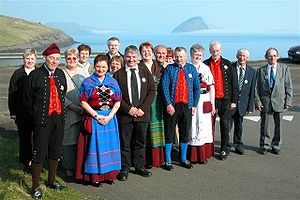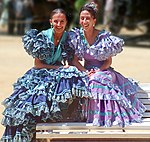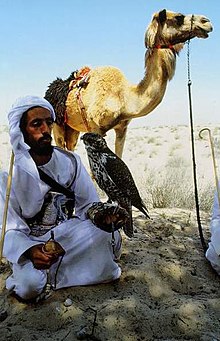Folk costume: Difference between revisions
No edit summary |
Rochelimit (talk | contribs) →Southeast Asia and Pacific: organized indonesia |
||
| Line 100: | Line 100: | ||
* [[French Polynesia]] - [[Pareo]] |
* [[French Polynesia]] - [[Pareo]] |
||
* [[Hawaii]] - [[Hawaiian Shirt]], [[Hawaiian Skirt]] |
* [[Hawaii]] - [[Hawaiian Shirt]], [[Hawaiian Skirt]] |
||
* [[Indonesia]] |
|||
* [[Indonesia]] Every region has its own specific design of a national costume. - Javanese male: Kain [[Batik]], [[Beskap]], [[Blangkon]], [[Sarong]], [[Klompen]]; Javanese female: Kain [[Batik]], [[Kebaya]], [[Klompen]]; Malay male: [[Baju Melayu]], [[Songkok]]/Peci; Malay female: [[Baju Kurung]], Kain [[Songket]]; Lampungese female: Kain [[Tapis (Indonesian weaving style)|Tapis]]; Sumba male and female: Kain [[Ikat|Tenun Ikat]]; Batakese female: Kain Ulos; [[koteka]] |
|||
** [[Batak people|Batak]] - [[Ulos]] |
|||
** [[Minangkabau people|Minangkabau]] - [[Baju Melayu]], [[Songkok|Peci]] (male); [[Baju Kurung]], Kain [[Songket]] (female) |
|||
** [[Lampung]] - Kain [[Tapis (Indonesian weaving style)|Tapis]] cloth, [[Palepai, Sumatran ships cloth|Palepai cloth]] |
|||
** [[Javanese people|Javanese]] - [[Batik]] cloth, [[:id:Beskap|Beskap]], [[Blangkon]], [[Sarong]], [[Klompen]], [[Kebaya]] (female) |
|||
** [[Balinese people|Balinese]] - Various [[Balinese textiles|Balinese cloth]] |
|||
** [[Dayak people]] - Sirat (loincloth) |
|||
** [[Sumba]] - [[Ikat|Tenun Ikat]] cloth, [{Textiles of Sumba|Lau]] |
|||
** [[Papua province]] and [[West Papua (province)|West Papua]] - [[Koteka]] |
|||
* [[Laos]] - [[xout lao]], [[suea pat]], [[pha hang]], [[pha biang]], [[sinh (clothing)|sinh]] |
* [[Laos]] - [[xout lao]], [[suea pat]], [[pha hang]], [[pha biang]], [[sinh (clothing)|sinh]] |
||
* [[Malaysia]] - [[Baju Melayu]] (male), [[Baju Kurung]] (female), [[kebaya|Baju Kebaya]] (female), [[Songket]], [[Sarong]] |
* [[Malaysia]] - [[Baju Melayu]] (male), [[Baju Kurung]] (female), [[kebaya|Baju Kebaya]] (female), [[Songket]], [[Sarong]] |
||
Revision as of 04:36, 15 February 2014
This article needs additional citations for verification. (October 2010) |

Folk costume (also regional costume, national costume, or traditional garments) expresses an identity through
costume which is usually associated with a geographic area or a period of time in history, but can also indicate social, marital and/or religious status. Such costumes often come in two forms: one for everyday occasions, the other for festivals and formal wear.
Following the outbreak of romantic nationalism, the peasantry of Europe came to serve as models for all that appeared genuine and desirable. Their dress crystallised into so-called "typical" forms, and enthusiasts adopted it as part of their symbolism.
In areas where contemporary Western fashions have become usual, traditional garments are often worn at special events or celebrations, particularly those connected with cultural traditions, heritage, or pride.
In modern times there are instances where traditional garments are required by law, as in Bhutan, where the traditional Tibetan-style clothing of gho and kera for men, kira and toego for women, must be worn by all citizens—even those not of Tibetan heritage; or in Saudi Arabia, where women are required to wear the abaya in public.
Africa
West Africa
- Benin - lace Dashiki suit and Aso Oke Hat (male), lace Buba and wrapper set (female)
- Ghana - Kente cloth, Ghanaian smock, and Fila (male), Kente kaba and slit set and Kaftan (female)
- Liberia - Dashiki suit cats Kufi (male), Buba and skirt set, Buba and wrapper set, and Kaftan (female)
- Mali - Grand boubou and Kufi (male), Kaftan (female)
- Nigeria - Agbada and Isiagu (male), Buba and wrapper set (female), Fila, Aso Oke Hat
- Senegal - Senegalese kaftan and Kufi (male), Kaftan (female)
North Africa
- Algeria : Binouar (Sétif), Bikhmar (Ouargla), Blouza (Oran), Burnous (Algérie), Caftan (Algérie), Caftan El-Bey (Algérie), Chemsa (Jijel), Fergani[disambiguation needed] (Constantine), Gandoura (Algérie), Gandoura Annabiya (Annaba), Ghlila (Algiers), Haïek (Algérie), Jellaba (Algérie), Karakou (Algiers), Kachabia (Djelfa et Lagouat), Labsa Kbaylia (Kabylie), Labsa M'zabia (M'zab), Labsa Naïlia (Ouled Naïl), Labsa Touratia (Hoggar), Lefa we dlala (Annaba), Melhfa Chaouïa (Aures), Melhfa Sahraouia (Tindouf), Mlaya (Est algérien), Sarouel (Algérie), Sarouel Mdawer (Algiers)
- Egypt - Galabeya
- Morocco - Djellaba (male), Fez hat, Takchita (female)
- Sudan - Jalabiyyah, Taqiyyah, and Turban (male), Toob, a cotton women's dress (female)
Horn of Africa
- Ethiopia - Ethiopian suit (male), Habesha kemis (female)
- Somalia - Macawiis (male), Koofiyad (male), Jilbab (female), Dirac (female), Guntiino (female), thawb male
Central Africa
- Cameroon - Pagne
- Democratic Republic of the Congo - formerly Abacost; Wrapper (clothing)
East Africa
- Kenya - Dashiki, Kanzu, and Kofia (male), Kanga and Kitenge (female)
- Rwanda - Kanzu (male), Mushanana (female)
- Tanzania - Kanzu, Dashiki, and Kofia (male), Kanga and Gowni (female)
- Uganda - Kanzu, Dashiki, and Kofia (male), Gomesi (female)
Southern Africa
- South Africa - Afrikaners, British diaspora: slouch hat, Bermuda shorts, khaki; Zulus, Xhosa, etc.: Madiba shirt, shweshwe clothing, Zulu crown (isicholo)
- Zimbabwe - Safari shirt (male), Buba and skirt set (female)
Americas

- Argentina - Gaucho costume
- Bahamas - Junkanoo costumes
- Bermuda - Bermuda shorts, Gombey costumes
- Brazil - Each region has its own traditional costume. "Baiana" is a good example.
- Canada - Tuque, Parka, Ceinture fléchée, Red Serge, various forms of First Nations clothing.
- Chile - Huaso costume
- Colombia - Sombrero Vueltiao, ruana, white shirt, trousers and espadrilles (male), Sombrero Vueltiao, blouse, pollera and espadrilles (female); every region has its own specific design of a national costume.
- Cuba - Guayabera, Khaki pants, Panama hat or Fedora (male), Guayabera dress (female)
- Dominican Republic - Chacabana
- Guatemala - Huipil, Corte skirt, Tocado, Todosantero suit.
- Guyana - Shirt jacket (male), Booboo (female)
- Haiti - Karabela dress (female), Shirt jacket (male)
- Jamaica - Bandana skirt and peasant blouse (female), Bush jacket (male)
- Mexico - Charro suit, Guayabera, Huipil, Mariachi suit, Rebozo, Sarape, Sombrero
- Panama - Pollera
- Peru - Chullo, Poncho, Marinera dress
- Puerto Rico - Guayabera, Pantalons, and Panama hat (male), Plena or Bomba dress (Female)
- St. Lucia - Madras dress (female)
- Trinidad - Shirt-jac (male), Booboo (female) and Carnival costumes
- United States - Various forms of Native American clothing. Western wear derived from original American pioneer garb is traditional dress in Texas, the Southwest, and many rural communities, including cowboy hats, Western shirts, boots, jeans, prairie skirts, and bolo ties. Traditional Southern wear includes white seersucker suits and string ties for men, and sun hats and large dresses for women. Patriotic historic European-American costume, especially in the East, includes clothing styles of the Plymouth Pilgrims, Founding Fathers of the United States, William Penn, or Minutemen. Summer residents of Nantucket will often wear Nantucket Reds. Amish and some sects of Mormon fundamentalism preserve traditional 19th century clothing styles for those groups.
- Venezuela - Liqui liqui, pelo e' guama hat.
Asia
East Asia

South Asia
- Bangladesh - Kurta (men), Lungi (men), Sari (women), Dupatta (women), Sherwani (men)
- Sri Lanka - Dhoti and Lungi, Sarong, Sari
- Maldives - Dhivehi libaas (women) Sarong, long sleeved white shirt (men)
- Bhutan - Gho (male) and Kira (female)
- Nepal - Daura-Suruwal, (male) and Gunyou Cholo (female); Traditional Newar clothing
- Pakistan - Sherwani,[1] Shalwar Kameez[2]
- India - Nehru suit, Achkan, Dhoti, Kurta (male) and Sari (female), Chatta and mundu (female) Shalwar Kameez and Khara Dupatta.
Southeast Asia and Pacific

- Australia - Khaki shorts, slouch hat, Aboriginal Australian tribal dress
- Brunei - Baju Melayu (male), Baju Kurung, Baju Kebaya (female), Songket, Sarong
- Cambodia - Sampot, Apsara, Sabai.
- Cook Islands - Pareo
- Fiji - Sulu
- French Polynesia - Pareo
- Hawaii - Hawaiian Shirt, Hawaiian Skirt
- Indonesia
- Batak - Ulos
- Minangkabau - Baju Melayu, Peci (male); Baju Kurung, Kain Songket (female)
- Lampung - Kain Tapis cloth, Palepai cloth
- Javanese - Batik cloth, Beskap, Blangkon, Sarong, Klompen, Kebaya (female)
- Balinese - Various Balinese cloth
- Dayak people - Sirat (loincloth)
- Sumba - Tenun Ikat cloth, [{Textiles of Sumba|Lau]]
- Papua province and West Papua - Koteka
- Laos - xout lao, suea pat, pha hang, pha biang, sinh
- Malaysia - Baju Melayu (male), Baju Kurung (female), Baju Kebaya (female), Songket, Sarong
- Myanmar - Longyi
- New Zealand - Māori Flax Skirts
- Papua New Guinea - Indigenous costumes
- Philippines - Barong Tagalog (male) and Baro't saya (female)
- Samoa - Lavalava
- Thailand - chut thai, Thai female: Thai Chakkri, Thai Boromphiman, Thai Siwalai, Thai Chakkraphat, Thai Amarin, Thai Chitlada, Thai Ruean Ton, pha nung, and sinh, Thai male: suea phraratchathan, Both genders: chong kraben and sabai. Northern Thai male: sado, and khian hua
- Tonga - tupenu and ta'ovala
- Vietnam - Áo Dài, Áo Tứ Thân, Áo Bà Ba.
Europe



- Albania - Albanian Traditional Clothing
- Austria - Tracht, Dirndl
- Bulgaria - Nosia
- Croatia - Croatian national costume, Lika cap, Sibenik cap
- Czech Republic - Kroje
- England - morris costumes, Pearly kings and queens
- Faroe Islands - Føroysk klæði
- Finland - Every region has its own specific design of a national costume. (Sami) Gákti, Luhkka
- France - Breton shirt, Beret, Alsatian costume
- Georgia - Chokha (Every region has its own specific design of Chokha)
- Germany - Every region has its own specific design of a national costume. Examples for Bavaria: Tracht, Lederhosen, Dirndl
- Greece - Fustanella, Peplos, Chiton
- Hungary - Dolman, Pellisse
- Iceland - Þjóðbúningurinn
- Ireland - Aran sweater, Grandfather shirt, Flat cap, Irish walking hat, Aran Island Tam, Leine
- Italy - Italian folk dance costumes, Tarantella costumes
- Macedonia - Macedonian national costume
- Malta - Għonnella (Faldetta)
- Netherlands - Dutch cap, sabot
- Norway - Bunad; (Sami) Gákti, Luhkka
- Poland - National costumes of Poland, Kontusz, Czapka
- Portugal - Every region has its own specific design of a national costume. Nazarena and minhota are two examples.
- Romania - Romanian dress
- Ancient Rome - Toga, Stola
- Russia - Sarafan, Kokoshnik, Kosovorotka, Ushanka, Valenki; (Sami) Gákti, Luhkka
- Serbia - Serbian dress, Šajkača, Opanci
- Scotland - Highland dress: Kilt, tam o'shanter, doublet, trews, Aboyne dress, Brogues or ghillies
- Sicily - Coppola (cap), black or dark brown Waistcoat
- Slovakia - Kroj (embroidered traditional dress)
- Slovenia - Gorenjska noša (Upper Carniola)
- Spain - every autonomous region has its own national costume. The bata de cola or "flamenco tail gown" is the really national costume; with "Manila shawl" and "spanish high comb".
- Sweden - Sverigedräkten; 18th century: Nationella dräkten; (Sami) Gákti, Luhkka
- Ukraine - National costumes of Ukraine, Vyshyvanka, Sharovary, Żupan, Ukrainian wreath
- Wales - Traditional Welsh costume, Welsh hat
Greater Middle East



- Afghanistan - Afghan cap, turban, Shalwar Kameez in grey, blue or olive green. See also Pashtun dress.
- Chechnya - Chokha, Taqiyah (cap), ushanka in cold weather.
- Egypt - Jellabiya, dishdash, keffiyeh
- Israel - Tembel hat, Biblical sandals, Jewish religious clothing, Rekel, Bekishe, Homburg hat, Kippah.
- Iran - Kurta, Pajama, dark colored Sherwani, Turban, Niqab.
- Jordan - Keffiyeh, Royal Guard costume.
- Lebanon - Keffiyeh, Tantour
- Kurdistan - Shalwar (pants), Islamic dress.
- Palestine - Keffiyeh, Taqiyah (cap), Palestinian costumes.
- Pakistan - Sherwani, churidar, Peshawari pagri, karakul in winter.
- Saudi Arabia - Thawb, Agal, izaar, Bisht, jilbab, hijab.
- Turkey - Fez, Kaftan.
- United Arab Emirates - Thawb, Agal, Bisht, Abaya
- Yemen - Similar to Saudi Arabia, with the addition of an ornate jambiya and leather bandoliers.
See also
This section is empty. You can help by adding to it. (February 2013) |
Gallery
This section is empty. You can help by adding to it. (June 2011) |
Notes
- ^ Jinnah, Pakistan and Islamic Identity: The Search for Saladin - Akbar S. Ahmed - Google Books. Books.google.com. Retrieved 2012-06-14.
- ^ Unquiet Pasts: Risk Society, Lived Cultural Heritage, Re-Designing Reflexivity - Stephanie Koerner, Ian Russell - Google Books. Books.google.com. 2010-08-16. Retrieved 2012-06-14.
